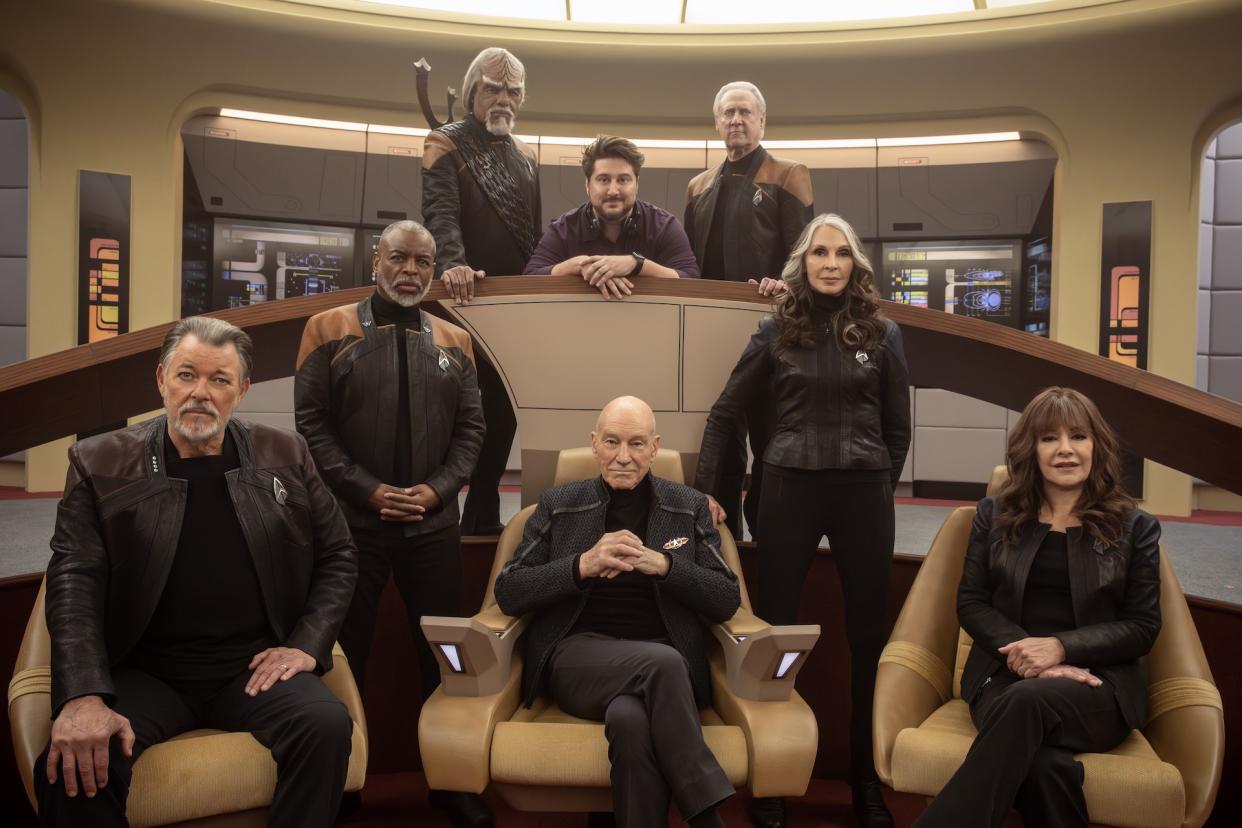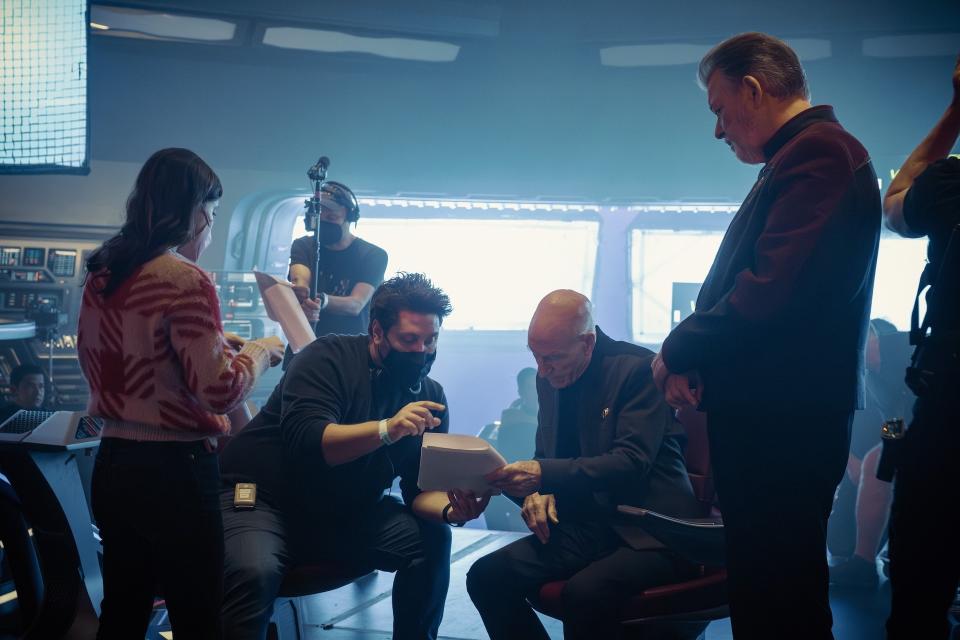‘Star Trek: Picard’ Season 3 Almost Didn’t Happen — but Had 1 Guiding Ethos When It Did

- Oops!Something went wrong.Please try again later.
- Oops!Something went wrong.Please try again later.
- Oops!Something went wrong.Please try again later.
- Oops!Something went wrong.Please try again later.
- Oops!Something went wrong.Please try again later.
“It was not going to be this.”
Terry Matalas doesn’t mince words about the difficulty of getting the “Next Generation” band back together for Season 3 of “Star Trek: Picard.” In fact, when he came onboard as showrunner prior to the second season, there was no plan for a reunion of the beloved Enterprise-D crew (nor an appearance from the ship itself).
More from IndieWire
'Euphoria' Season 3 Likely Won't Air Until 2025, Says HBO's Drama Chief
'Succession' Secured Its Place Among TV's Greats with One Massive Bet
“Because that was not the show they had set out to make,” he added in a new interview with IndieWire, alongside production designer Dave Blass. “‘Picard’ was the deconstruction of Jean-Luc Picard, and it had a new cast, and there’s nothing wrong with that.”
Matalas knew, though, that bringing back the full “Next Generation” cast for one final adventure — after their voyages came to a thud of an end with 2002’s “Star Trek: Nemesis” — would be electric if it happened.
He made it so.
Fans greeted “Picard” Season 3 with what can only be described as a euphoric response. Matalas and his army of craftspeople followed one goal, as Blass puts it: “‘Let’s find an updated version of what we had already loved.’ Our idea was not to change [‘Trek’] but to update. And I think that that simple difference from changing it to updating it was core to our ideas.”
Unlike a lot of nostalgia-fueled reteams, this didn’t mean just redoing what they had done before: it meant that, since we haven’t seen these characters for 20 years, we should see the changes in their lives that those decades have entailed. To deliver a true reunion, Matalas needed to bring back more than just the on-camera talent from the ‘90s. Though that alone was quite a task.
“‘It’s gonna be up to you, Terry, to walk into all these rooms and convince all these parties it’s possible,’” Matalas recalled franchise execs Alex Kurtzman and Akiva Goldsman saying. “‘But how are you going to do it?’ And both Alex and Akiva were lovely about that support but were very much like, ‘This is on you to do.’ They were fantastic about it, but I didn’t sleep very much.”
Months of phone calls and meetings later, not only was Patrick Stewart back as the title character, but so were Gates McFadden as Beverly Crusher, Michael Dorn as Worf, Jonathan Frakes as Riker, Marina Sirtis as Troi, Brent Spiner as Data (yes, Data, who died twice before this), and LeVar Burton as Geordi. Matalas was particularly eager to pitch Burton a vision of Geordi in a more fulfilled place — as a father of two daughters in a healthy relationship — than he was sometimes presented as being on “Next Gen.” There wasn’t much they felt truly needed a redo from “Next Gen,” but the showrunner said “that was a big one,” and Burton was in.
To truly realize the world of “Next Gen” some 20 years on, Matalas and Blass also brought back about a dozen of the craftspeople who worked on the show and other “Trek” series and movies in the ‘90s. Among them were Denise and Michael Okuda, who designed the LCARS computer interfaces for the bridge set and turbolifts on the ‘90s shows, concept designer and VFX artist Doug Drexler, visual effects producer Dan Curry, starship designer John Eaves, and computer and video playback specialist Todd A. Marks. The goal was to organically build on what came before.

As a conceptual exercise, Blass would challenge his artists to think, “‘OK, what does an elevator look like in our world? What does an elevator look like 20 years ago? How much change really goes on in our architecture during that span of time?’ And it doesn’t, things don’t change that much. So we really went back to what we had seen of the last versions in ‘Voyager’ and ‘Deep Space Nine’ and the ‘Next Generation’ movies and said, ‘OK, that’s what we’re going to do, and then we’re just going to elevate it a little bit and improve the tech and blend it with our technology.'”
For instance, the LCARS computer interfaces that had once been pastel-colored decals stretched across light-up displays could now be replaced with actual animations appearing on hi-def monitors thanks to Marks, who’d previously worked on “Star Trek: Nemesis.” Where they had a muted glow before, now they popped, especially on the sets for the new ship, the U.S.S. Titan, which is meant to be state-of-the-art and the best of Starfleet technology at the dawn of the 25th century.
Likewise, Blass added, “Worf gets a brand new weapon, and rather than having some guy do it, it’s like, ‘No, let’s call Dan Curry, who designed the [Klingon weapon] bat’leth, and let’s get him to create it because he has a relationship with Michael.” Even the design of the villains’ starship, the Shrike, was inspired by old work: master Hollywood knife creator Gil Hibben’s blade for Tom Hardy’s character in “Nemesis,” with its pronged side-spurs curving forward like pincers.
“One of the things I said to my team was, ‘”Star Trek” is not a fantasy show,’” Blass said. “It’s not a sci-fi show. It’s a historical drama that takes place in space. But it’s got 60 years of history that we have to be true to.”
![Designers from 40 years of Trek come together to recreate the USS Enterprise D again [L-R] Garret Flaming, Todd Marks, Mike Okuda & Denise Okuda, Doug Drexler, Geoffrey Mandel, Dave Blass, and Liz Kloczkowski](https://s.yimg.com/ny/api/res/1.2/l9n8iGHtScJgvEFMjf98Jg--/YXBwaWQ9aGlnaGxhbmRlcjt3PTk2MDtoPTcyMA--/https://media.zenfs.com/en/indiewire_268/cd8b413dada8c83beab50b5ce5f783bd)
There was one thing that needed not an update but a meticulous recreation: The Enterprise-D bridge set, which made its appearance in the penultimate episode of Season 3, as if it were the last character needed for the reunion to truly be complete. And indeed, it was.
For just two days of shooting, Blass and his artisans spent over three months recreating the bridge, with its muted ‘90s beige and brown hues and curving wooden arch that encircles the captain, first officer, and counselor and provides the raised console where tactical officer Worf stands. Nothing remained of this except the original blueprints and records of changes made to the set from season to season of the original show. It wasn’t just a set; it was a vibe. With its much-talked-about carpet, the Enterprise-D bridge conveyed not just a vehicle but a place of comfort.
“There’s the archway where Worf stands, and the painters got exactly the right number of grains in the wood and the knot is at the exact spot it was originally,” Blass said. “Because [his artisans] were like, ‘Oh, no, we looked at the photo. We got it from this and it’s this type of wood with this grain tool. We bought the same graining tool to achieve that effect.” The set, a veritable museum piece you could charge tickets to visit, has been preserved this time around.
But from the bridge, where the ‘90s were brought back to life, down to DP Jon Joffin trying to marry the style of ‘90s TV lighting with today’s techniques (this season filmed in 2021), some subtle updates were made. The LCARS decals in the ‘90s were blue but appeared to viewers with a greenish hue because of the way they were filmed; so Marks added a bit of green to those animations for his HD video playback version of the buttons and indicators.
For Matalas and Blass none of these things were about “fan service.” As Blass put it, “The things that people call Easter eggs, it’s like, ‘No, we’re just getting it accurate.’”
And so they did.
Best of IndieWire
Sign up for Indiewire's Newsletter. For the latest news, follow us on Facebook, Twitter, and Instagram.

